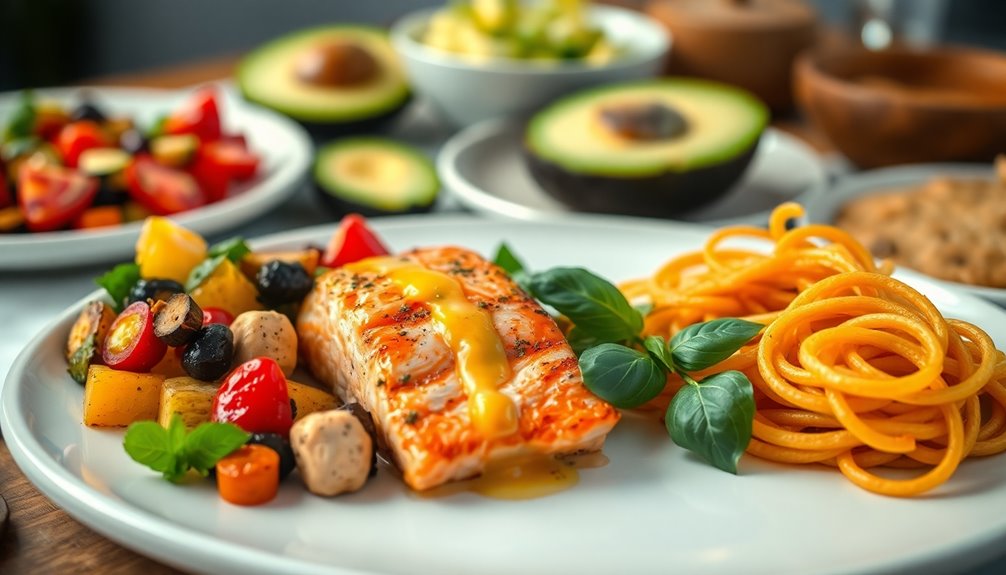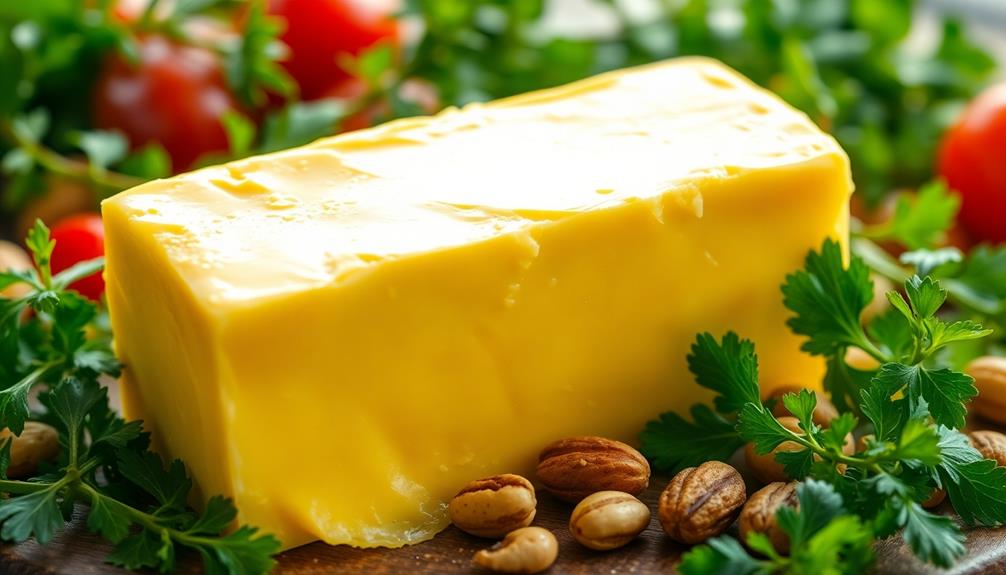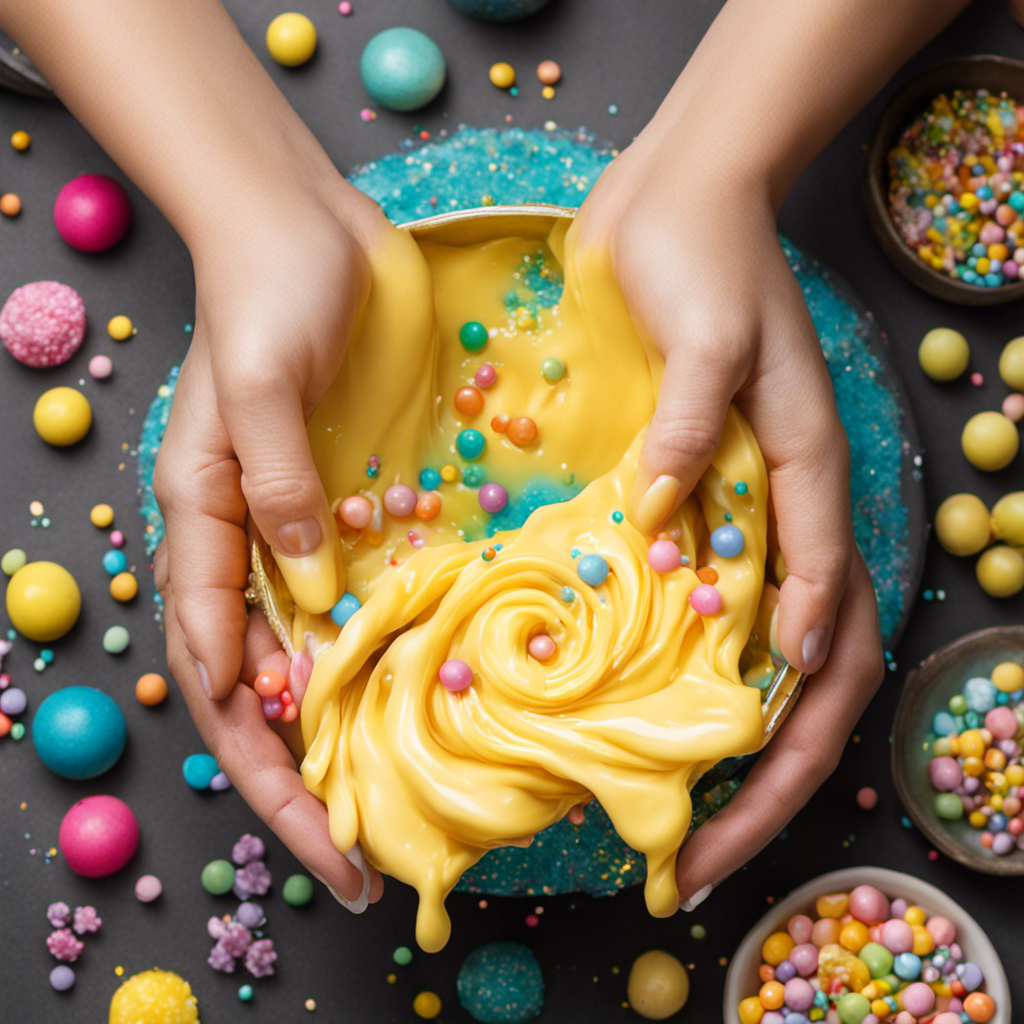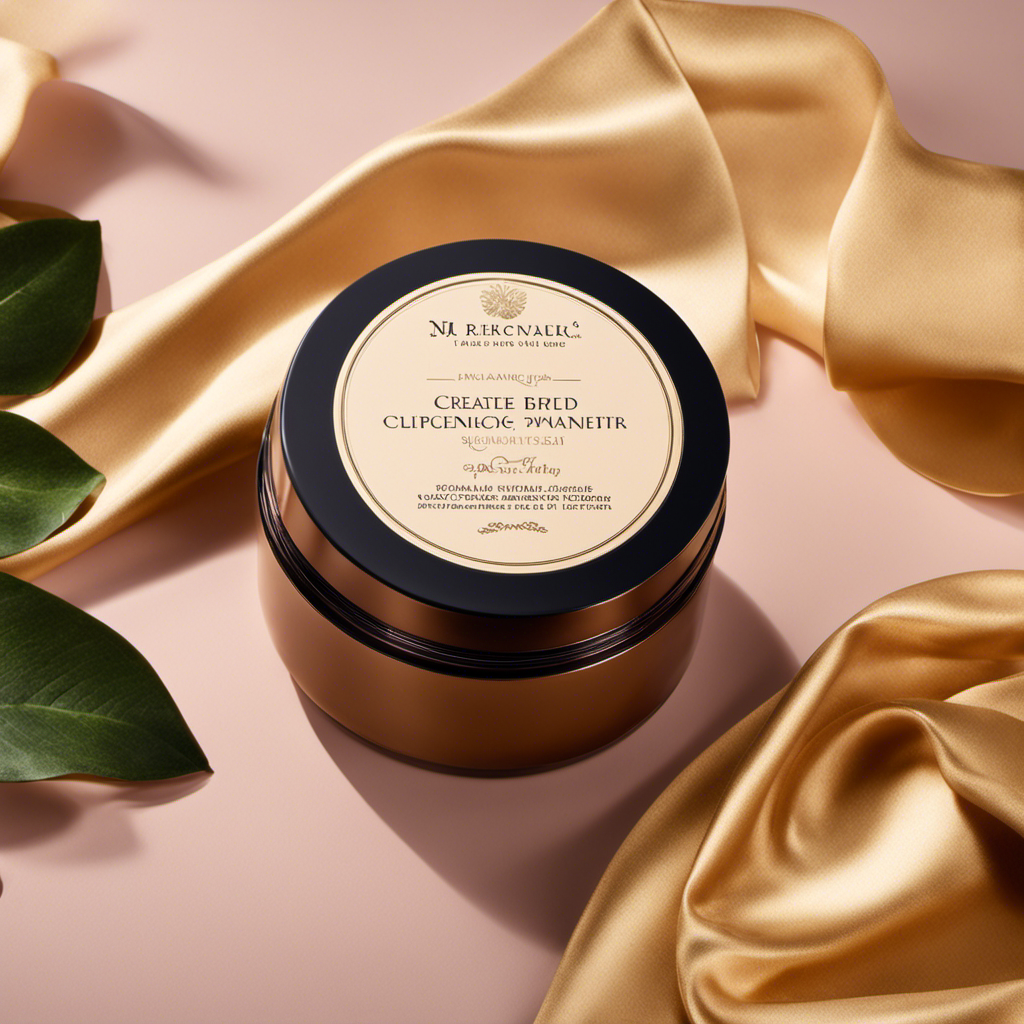Butter's cultural significance is rich and varied, deeply embedded in cuisines and traditions around the globe. You'll find it celebrating abundance, hospitality, and comfort in many societies. In culinary spaces, it enhances flavors, from pastries in Europe to ghee in India. Symbolically, butter plays a role in rituals and ceremonies, often seen as a purifying offering in spiritual contexts. Its historical roots date back thousands of years, showcasing its enduring presence. As you explore this delightful ingredient, you might discover its impact on art, celebrations, and even modern cooking trends. There's much more to uncover!
Key Takeaways
- Butter has ancient origins, dating back to 2000 B.C., and has been a staple in various culinary traditions worldwide.
- Symbolizing wealth, hospitality, and comfort, butter plays a significant role in rituals, celebrations, and life events across cultures.
- Different regions produce unique butters, such as French cultured butter and Indian ghee, reflecting local tastes and heritage.
- Butter is integral to both culinary practices and religious ceremonies, representing purity and connection to the divine.
- Modern perspectives embrace butter's versatility and nutritional value, promoting artisanal and sustainable practices in contemporary cooking.
Historical Roots of Butter
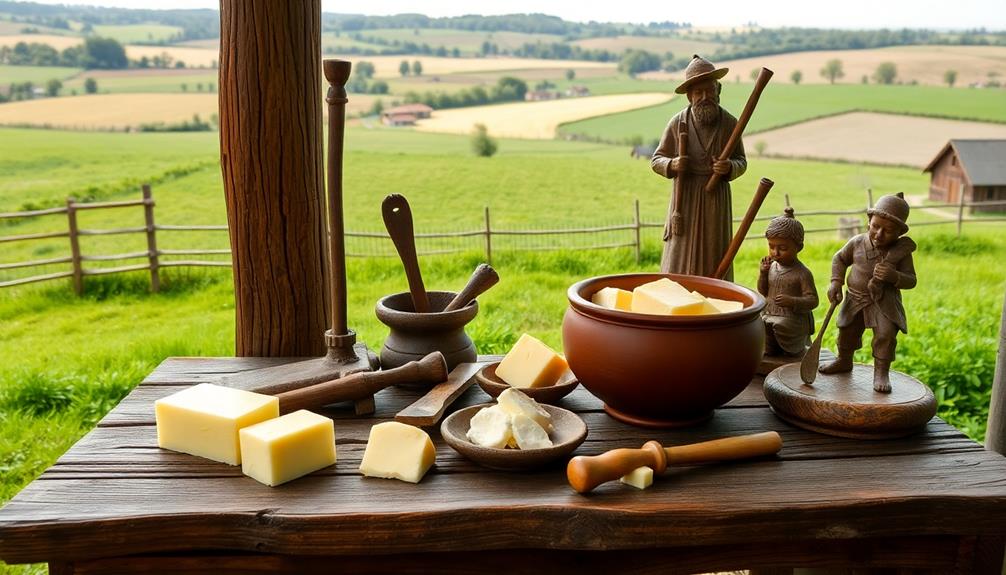
Butter's historical roots run deep, tracing back thousands of years to ancient civilizations. You might be surprised to learn that evidence of butter-making dates as far back as 2000 B.C. in regions like Mesopotamia. Early cultures used milk from domesticated animals, churning it to create the creamy substance we recognize today. This process not only preserved the milk but also enhanced its flavor and nutritional value.
As you explore ancient texts and archaeological findings, you'll notice that butter played an essential role in daily life. It served as a staple food, a cooking fat, and even a key ingredient in various dishes. In many societies, butter was a symbol of wealth and generosity, often offered to guests or used in celebrations.
You can see how butter's versatility transcended cultures, influencing culinary traditions worldwide. From the rich, spiced butter of Indian cuisine to the delicate, whipped varieties enjoyed in Europe, it adapted to local tastes and customs.
Butter's evolution over the centuries reflects human ingenuity and the importance of food in cultural identity, making it a fascinating subject to explore further.
Butter in Religious Practices
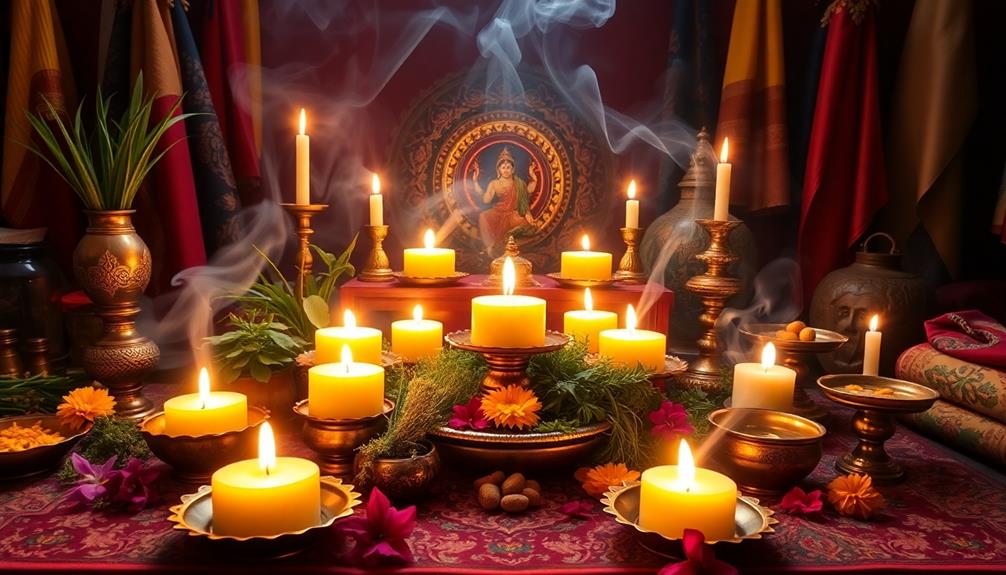
When you explore butter's role in religious practices, you'll find it often serves as a sacred offering in various rituals.
Many cultures regard butter as a symbol of purity, using it to enhance spiritual connections.
This highlights how butter transcends mere culinary use, embodying deeper meanings in spiritual contexts.
Sacred Offerings and Rituals
Throughout history, butter has held a revered place in various religious practices, serving as both a symbol of purity and a medium for sacred offerings. You'll find butter being used in rituals across different cultures, often representing nourishment and abundance in spiritual traditions.
In Hinduism, for instance, ghee, a clarified form of butter, is essential in offerings to deities during pujas. It's believed that the aroma of ghee attracts divine presence and blessings.
In some African cultures, butter is used in rituals to honor ancestors or spirits, symbolizing respect and gratitude. You might also encounter the practice of using butter in Tibetan Buddhism, where it plays a role in creating butter sculptures for offerings during festivals.
In these ceremonies, you can see how butter transcends mere culinary use, embodying spiritual significance. It serves as a way to connect the earthly domain with the divine, reinforcing communal bonds and shared beliefs.
When you participate in these rituals, you're not just honoring traditions; you're engaging with a rich tapestry of cultural heritage that values the sacredness of this simple yet profound ingredient.
Symbol of Purity
In many religious practices, butter serves as a powerful symbol of purity, representing both physical and spiritual cleanliness. You might encounter butter in rituals where it's used as an offering to deities, highlighting its sacred nature.
In Hinduism, for instance, ghee, a clarified form of butter, is integral to various ceremonies. When you offer ghee in a sacred fire, it's believed to purify the surroundings and connect you with the divine.
Moreover, in many cultures, butter is associated with light and nourishment, reinforcing its role in spiritual practices. When you incorporate butter into your rituals, you're embracing a symbol that transcends mere food—it's a conduit for spiritual energy.
In Tibetan Buddhism, butter lamps are lit to dispel darkness and symbolize wisdom. Lighting these lamps isn't just a ritual; it's a way for you to seek clarity and enlightenment.
As you reflect on butter's role in these spiritual contexts, you'll notice its deeper significance. It represents a bridge between the material and the divine, inviting you to explore the purity that lies within and around you.
Symbolism of Butter in Cultures
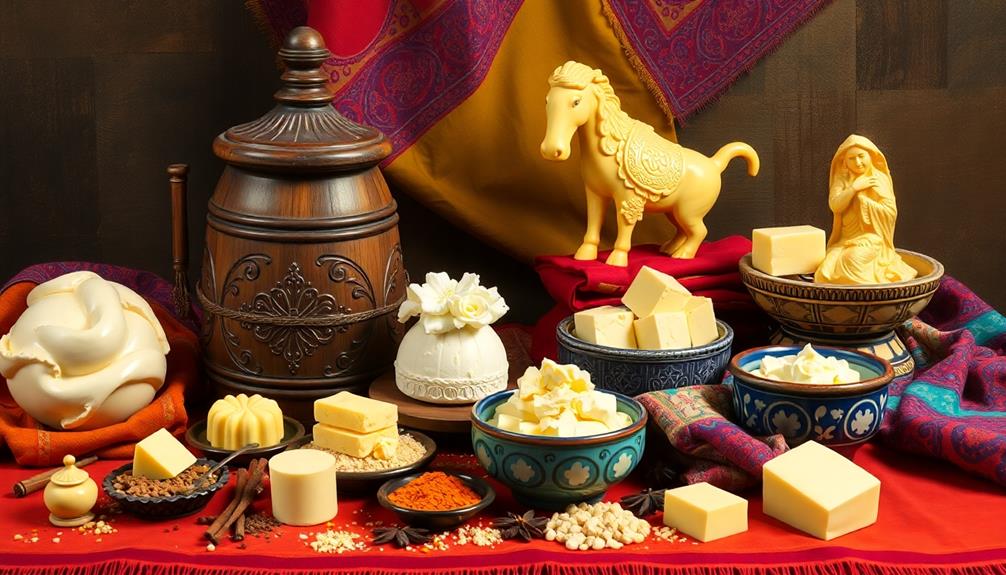
When you explore the symbolism of butter in various cultures, you'll find it plays a key role in rituals and traditions.
Its creamy texture and rich flavor often carry deeper meanings in culinary practices, making it a staple in many dishes.
Butter serves as a sacred offering in cultural rites, symbolizing prosperity and hospitality, as seen in traditions like Tibetan Buddhism.
Understanding these aspects helps you appreciate how butter connects to cultural identity and heritage.
Rituals and Traditions
Butter serves as a powerful symbol in various cultural rituals and traditions, transcending its role as a mere ingredient. In many societies, it's used in religious ceremonies and rites of passage, symbolizing purity, fertility, and prosperity.
For instance, in Hindu traditions, you might find ghee (clarified butter) being offered to deities during worship, representing devotion and respect.
You'll also notice butter's significance in life events, such as weddings and births. In some cultures, families spread butter on the couple's path during weddings, signifying a smooth and prosperous journey ahead.
When welcoming a newborn, butter may be smeared on the baby's forehead, invoking blessings and good fortune.
In African traditions, butter plays a role in communal rituals, where it's often mixed with herbs for healing practices. This highlights its importance in connecting people to their cultural roots and shared heritage.
Culinary Symbolism and Meanings
Often celebrated for its rich flavor and smooth texture, butter carries deep culinary symbolism across various cultures. People often use butter not just as an ingredient but as a representation of hospitality, richness, and comfort.
Here are three key symbolic meanings of butter:
- Nourishment and Care: In many cultures, butter signifies nourishment. It's often used in family meals, representing care and love. When you spread butter on bread, you're sharing warmth and comfort.
- Celebration and Joy: Butter plays a significant role in festive meals. From creamy sauces to buttery pastries, its presence often marks special occasions, symbolizing joy and abundance.
- Purity and Goodness: In some traditions, butter is seen as a symbol of purity. It's commonly used in religious offerings, representing a connection to the divine and the goodness of life.
Through its rich culinary symbolism, butter transcends mere taste, becoming an essential part of cultural identity.
Culinary Uses Across Continents
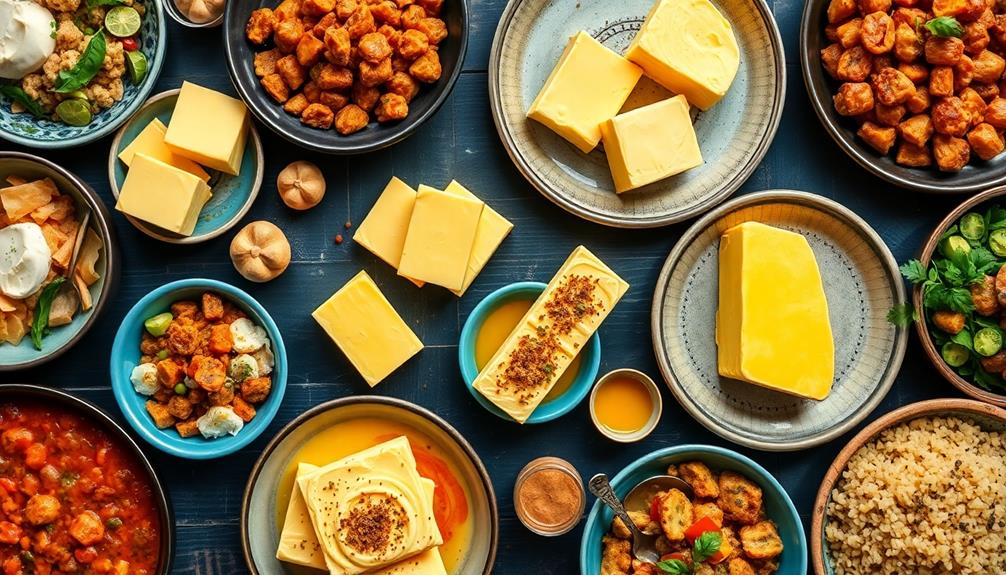
Throughout history, various cultures have embraced butter as a culinary staple, showcasing its versatility in diverse dishes. In Europe, you might find butter enriching everything from flaky pastries in France to creamy sauces in Italy. The French often use it to sauté vegetables or as a base for sauces, while Italians incorporate it into risottos and pasta dishes, enhancing flavor and texture.
Butter's ability to add moisture and richness makes it a significant ingredient in baking, which is evident in how it contributes to the texture of cookies and cakes. Additionally, butter is a source of essential vitamins butter is nutrient-rich, making it a valuable addition to a balanced diet.
In India, ghee, a clarified form of butter, is essential in many traditional recipes. You'll see it used in everything from curries to sweets, adding a rich taste and aroma.
Meanwhile, in the Americas, butter plays an important role in baking, giving cookies and cakes their signature moistness and flavor.
As you explore Asian cuisines, you'll discover that butter isn't always the star. In some regions, it's blended with spices to create unique flavor profiles.
In Africa, you might encounter shea butter, which not only serves culinary purposes but also has cultural significance in various dishes.
From frying to baking, butter's rich history and global adaptations make it a beloved ingredient in kitchens around the world, connecting cultures through its delightful taste and texture.
Butter in Festivals and Celebrations

In many cultures, butter plays an essential role in festivals and celebrations, symbolizing abundance and joy. Its rich, creamy texture often enhances special dishes, making gatherings more festive.
Its high-fat content contributes to the comforting nature of festive foods, as butter provides essential fatty acids. Whether it's smeared on bread or used in decadent desserts, butter elevates the culinary experience during these occasions.
Here are three ways butter shines in celebrations:
- Religious Rituals: In Hindu ceremonies, clarified butter, or ghee, is used for offerings to deities, symbolizing purity and devotion.
- Festive Foods: During Christmas, butter is a key ingredient in cookies and cakes, bringing warmth and comfort to holiday gatherings. It's a staple in traditional recipes that families pass down through generations.
- Cultural Dishes: In African cultures, butter is often incorporated into meals for significant celebrations, representing prosperity and community sharing.
Traditional Methods of Butter Making
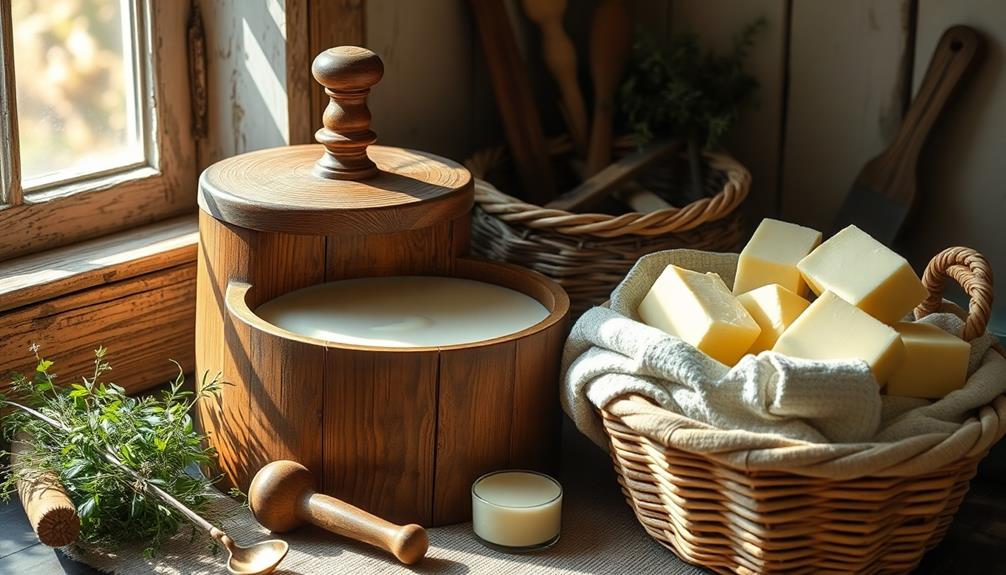
While many people enjoy butter today, the traditional methods of making it have deep roots in history and culture. You might be surprised to learn that butter-making can be a hands-on, rewarding experience.
Traditionally, this process begins with fresh cream, often sourced from local farms. You'd pour the cream into a container, like a churn or even a jar, then shake or churn it vigorously.
As you work the cream, you'll notice it thickening and eventually separating into solid butter and buttermilk. This can take anywhere from a few minutes to several hours, depending on the method you choose.
Once the butter forms, it's essential to rinse it under cold water to remove any residual buttermilk, which can spoil the butter over time.
Afterward, you can shape the butter into blocks or rolls. Some cultures add salt for flavor or preservation. You might also see variations where herbs and spices are blended in for a unique twist.
This hands-on approach not only connects you to culinary traditions but also enhances your appreciation for this beloved ingredient. Embracing these traditional methods can deepen your relationship with butter and its cultural significance.
Regional Variations and Specialties
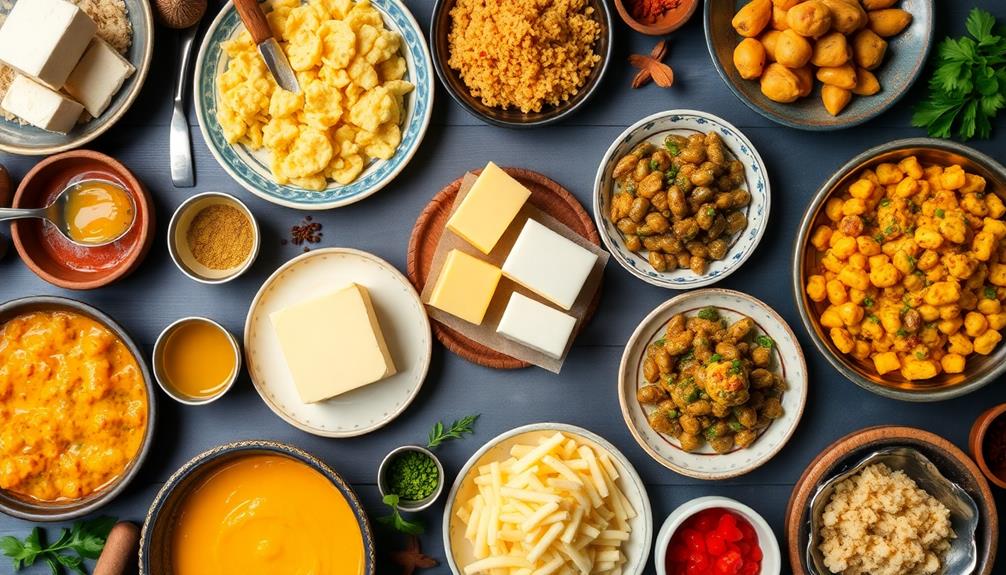
Butter isn't just a staple ingredient; it varies widely across different regions, each boasting its own unique specialties.
When you explore the world of butter, you'll discover fascinating variations that reflect local tastes and traditions. Here are three notable examples:
- French Cultured Butter: In France, butter is often cultured, meaning it's fermented before churning. This process gives it a tangy flavor and creamy texture, making it perfect for pastries or simply spreading on fresh bread.
- Irish Grass-Fed Butter: Known for its vibrant yellow color, Irish butter comes from cows that graze on lush pastures. This results in a rich, slightly sweet flavor that elevates everything from baking to cooking.
- Indian Ghee: In India, ghee is a beloved clarified butter used in countless dishes. Its nutty aroma and high smoke point make it ideal for frying and sautéing, while it also holds cultural significance in rituals and celebrations.
These regional specialties highlight how butter isn't just an ingredient; it's a reflection of cultural heritage and local practices that enhance culinary experiences around the globe.
Butter in Art and Literature
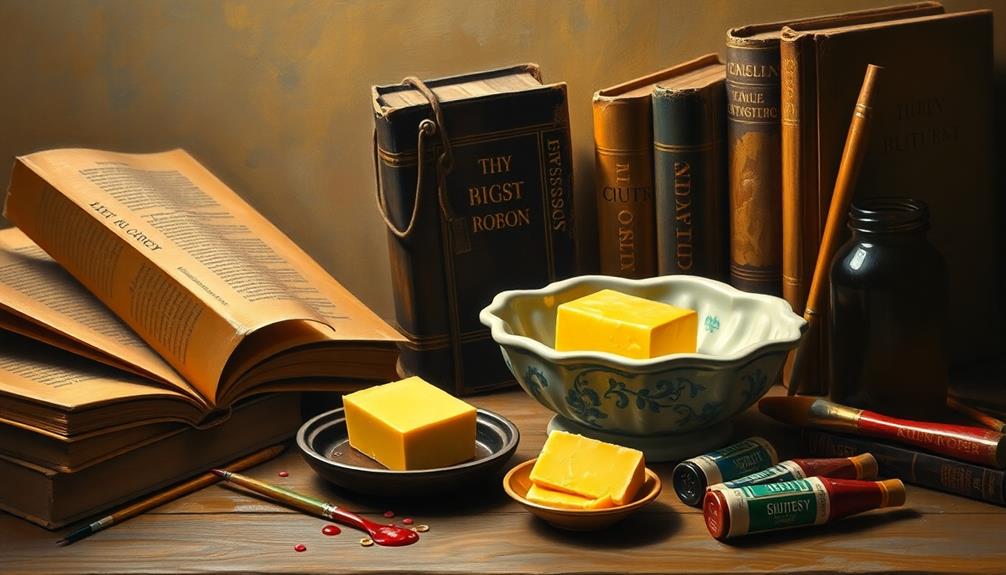
The richness of butter transcends mere culinary function, finding its way into the domains of art and literature as a symbol of indulgence and comfort. Writers and artists have long used butter to evoke feelings of warmth, nostalgia, and even decadence. You might recall passages where buttered bread is described, instantly transporting you to a cozy kitchen filled with the scent of baked goods.
In literature, butter often represents the simple pleasures of life. It's featured in poetry and prose as a metaphor for abundance and the joy of small moments. Similarly, in visual art, butter's creamy texture and golden hue captivate viewers, inviting them to savor the experience.
Here's a quick overview of butter's significance in art and literature:
| Medium | Cultural Reference |
|---|---|
| Literature | Symbol of comfort and nostalgia |
| Visual Art | Represents abundance and warmth |
| Folklore | Often associated with home and family |
This table highlights how butter enriches our understanding of cultural narratives, making it much more than just a kitchen staple.
Modern Perspectives on Butter
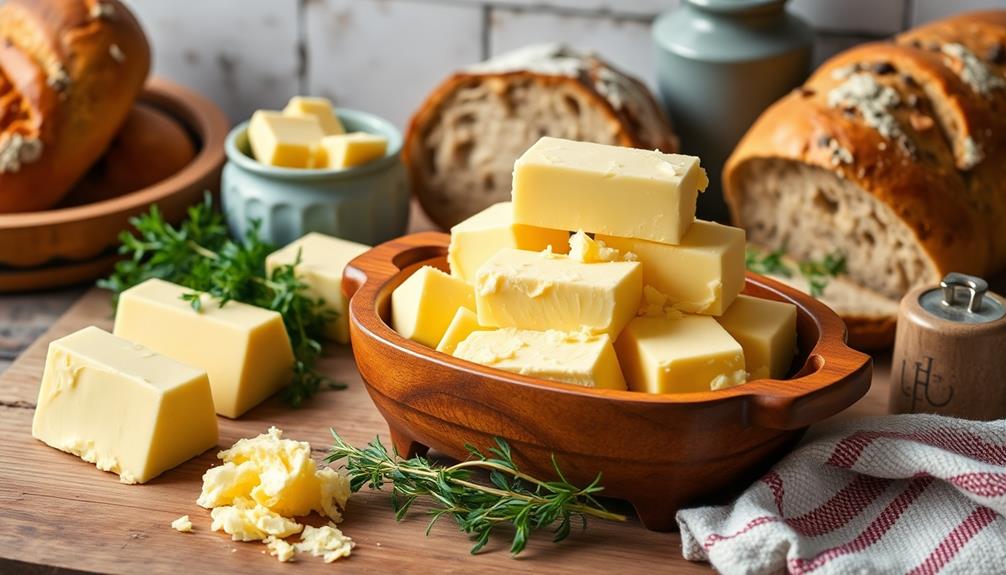
In today's culinary landscape, butter has seen a remarkable resurgence, moving beyond its traditional role to become a celebrated ingredient in gourmet cooking and health-conscious diets alike.
You might be surprised to discover how versatile and beneficial butter can be when used thoughtfully.
Here are three modern perspectives on butter that highlight its significance:
- Culinary Versatility: Chefs are now embracing butter not just for flavor, but for its ability to enhance textures and elevate dishes. From rich sauces to baked goods, butter plays a pivotal role in countless recipes.
- Nutritional Value: With the rise of the "real food" movement, butter's reputation has shifted. People are recognizing its healthy fats, vitamins, and minerals, especially when sourced from grass-fed cows.
- Sustainable Practices: Many consumers are opting for artisanal butters, supporting local farms that prioritize sustainable practices. This shift not only benefits your palate but also fosters a more ethical food system.
As you explore these modern perspectives, you'll find that butter isn't just a cooking staple; it's a dynamic ingredient that reflects evolving tastes and values in our diets.
Frequently Asked Questions
What Are the Health Benefits of Butter Compared to Margarine?
When comparing butter to margarine, you'll find butter contains natural fats and vitamins A, D, E, and K. Margarine, while lower in saturated fat, often contains trans fats, which can be harmful to your health.
How Has Butter Consumption Changed in Recent Years?
You've probably noticed butter consumption's increased popularity recently, driven by trends favoring natural ingredients. Many people now prefer butter over margarine, believing it's healthier and more flavorful, leading to a resurgence in traditional recipes and cooking methods.
Are There Vegan Alternatives to Traditional Butter?
If you're seeking creamy substitutes, search no more! You've got options like coconut oil, nut butters, and avocado spread. These vegan alternatives not only mimic butter's texture but also add unique flavors to your dishes.
What Environmental Impact Does Butter Production Have?
Butter production contributes greatly to greenhouse gas emissions, deforestation, and water usage. When you think about it, the livestock farming involved creates a large environmental footprint, impacting climate change and resource depletion more than you'd expect.
Can Butter Be Used in Skincare or Beauty Products?
Yes, you can use butter in skincare! Its moisturizing properties help hydrate and soften your skin. Just remember to test it on a small area first to avoid any potential allergic reactions. Enjoy your natural beauty routine!
Conclusion
In exploring the cultural significance of butter, you've seen how it connects us across history, religion, and cuisine. Did you know that the average American consumes about 5.6 pounds of butter each year? That's a lot of deliciousness! Whether it's in a holiday dish or a simple spread, butter continues to hold a special place in our hearts and kitchens. Embracing its rich traditions can deepen your appreciation for this beloved ingredient.
